DOWNLOADS
Holy Places in Karnataka
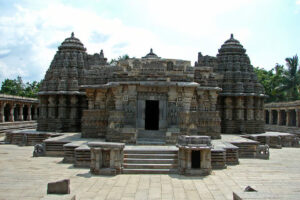 Religious places in Karnataka are rich, vibrant and colourful and range across numerous religions. From temples, mosques, churches and gurudwaras, Karnataka has a range of holy places of worship. The diversity of Karnataka isn't just in its art and history but also in religious ethnicity. Combined with their long histories, the religious heritage of the state has translated into various religious sites.
Religious places in Karnataka are rich, vibrant and colourful and range across numerous religions. From temples, mosques, churches and gurudwaras, Karnataka has a range of holy places of worship. The diversity of Karnataka isn't just in its art and history but also in religious ethnicity. Combined with their long histories, the religious heritage of the state has translated into various religious sites.
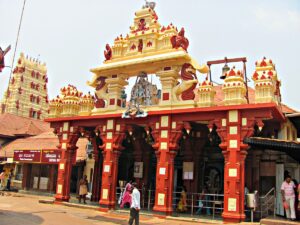 one of the most famous pilgrimage sites in South India, the Krishna Temple or the Udupi Sri Krishna Matha is one of the most auspicious temples dedicated to Lord Krishna. The idol of Krishna is adorned with jewels and a golden chariot. What makes the temple unique, is its worshipping pattern. The prayers and process of the whole worship take place only through a silver-plated window with nine holes called the Navagraha Kitiki. A temple known as Udupi Anantheshwara Temple surrounds the Shree Krishna Matha. This temple traces back to 1,000 years.
one of the most famous pilgrimage sites in South India, the Krishna Temple or the Udupi Sri Krishna Matha is one of the most auspicious temples dedicated to Lord Krishna. The idol of Krishna is adorned with jewels and a golden chariot. What makes the temple unique, is its worshipping pattern. The prayers and process of the whole worship take place only through a silver-plated window with nine holes called the Navagraha Kitiki. A temple known as Udupi Anantheshwara Temple surrounds the Shree Krishna Matha. This temple traces back to 1,000 years.
The temple bears a resemblance to a living ashram, fostering daily life and devotion. It is also the birthplace of Daasa Sahitya, a Udupi form of literature. Every two years, the administration and temple offerings are managed cyclically between the eight mathas. They are collectively known as Ashta Mathagalu.
Every year, the Krishna Temple attracts thousands of devotees, and daily prayers begin with the blowing of a conch shell at 4:00 AM. Several festivals like Ramanavami, Deepavali, Krishnashtami, Hanuman Jayanti, Saptotsava or the Seven Utsavas (celebrated in January) and the Paryaya festival (once in every two years).
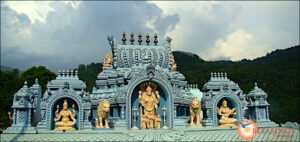 The Annapoorneshwari Temple is a Hindu temple dedicated to the goddess Annapoorneshwari (Annapoorna) located at Horanadu, Karnataka, India, 100 km from Chikmagalur in the thick forests and valleys of the Western Ghats of Karnataka. It is situated on the banks of river Bhadra.
The Annapoorneshwari Temple is a Hindu temple dedicated to the goddess Annapoorneshwari (Annapoorna) located at Horanadu, Karnataka, India, 100 km from Chikmagalur in the thick forests and valleys of the Western Ghats of Karnataka. It is situated on the banks of river Bhadra.
Due to Brahma's ego, Shiva beheaded his fifth head, which signified the ego of Brahma. Brahma's head decayed and his skull got stuck in Shiva’s hand. Brahma cursed him that till the skull is not full of food or grains, it will stick to his hands. Shiva took the form of a beggar, Bhikshatana, roamed the earth and asked for food but the skull was never full. So he finally went to his wife Parvati who had taken the form of Annapurneshwari and she filled the skull with grains and reversed Shiva’s curse.
Annapoorneshwari's idol can be seen here in a standing pose on a peetha (pedestal). She is holding the Shankha, Chakra, and an etching of the Sri Yantra on her left hand in Varadamudra and a carving of the goddess Gayatri on her right hand in abhayamudra. The idol is covered in gold from head to toe with carvings of various goddesses like Saraswati, Lakshmi, Durga, Kali, etc, and it is believed that who so ever visits her, will never go hungry in their lives.
Hereditary Dharmakartharu priests started in this temple from past 400 years. The same family is serving and preserving the temple since then. Dharmakartharu have played an instrumental role in refurbishing the temple as well as in performing the rituals here. The temple premise was small and unknown to many till the fifth Dharmakartharu Sri D.B. Venkatasubba Jois repaired and revived the temple. The goddess icon was reestablished in 1973 on the auspicious day of Akshaya Tritiya
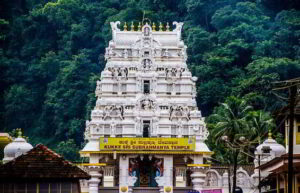 The Kukke Subrahmanya Temple is a famous Hindu temple that is located in Karnataka, India. Lord Kartikeya, who is the lord of all serpents, is worshipped here as Lord Subrahmanya; and the temple provides tranquillity and peace like no other. It is located in the heart of the village of Subrahmanya, in Dakshina Kannada, and is surrounded by lush nature on all sides. The mountain Kumara Parvatha overlooks the temple adding a mystical charm. If seen geographically, Shesha Parvatha, a mountain shaped like a six-headed cobra, adjacent to Kumara Parvatha seems to protect the temple.
The Kukke Subrahmanya Temple is a famous Hindu temple that is located in Karnataka, India. Lord Kartikeya, who is the lord of all serpents, is worshipped here as Lord Subrahmanya; and the temple provides tranquillity and peace like no other. It is located in the heart of the village of Subrahmanya, in Dakshina Kannada, and is surrounded by lush nature on all sides. The mountain Kumara Parvatha overlooks the temple adding a mystical charm. If seen geographically, Shesha Parvatha, a mountain shaped like a six-headed cobra, adjacent to Kumara Parvatha seems to protect the temple.
The Kukke Subrahmanya Temple is considered to be the abode of 'nagas', and pooja or prayer here is offered to Lord Subrahmanya, along with the serpent king Vasuki. Devotees also believe that the holy bath here in the Kumaradhara Thirtha and Madesnana eradicates dreaded diseases like leprosy. According to devotees, diseases related to the skin even get cured here. The temple is also considered to be the ultimate place to attain salvation for all those who are suffering from any kind of 'naga doshas'. This is the ideal place for Naga Dosha Pariharam (remedy), by performing Sarpa Samskara Pooja, Ashlesha Pooja and other such rituals. In fact, a lot of devotees from all across the country visit the temple for precisely this purpose.
The annual festival celebrated at the Kukke Subrahmanya Temple begins from the 'Karthika Bahula Dwadashi' and goes on till the 'Margashira Shudha Poornima'. The day of Karthika Bahula Amavasya is celebrated as 'Lakshadeepotsava', which is followed by the celebrations of Chandramandalotsava, Ashwavahanotsava, Mayura Vahanotsava and Flower Chariot Utsava respectively on the four succeeding days. On the fifth day, 'Panchami Rathotsava' is celebrated at night.
On the Shashti day, Sri Subrahmanya Swamy and Umamaheshwara appear at an auspicious hour in the morning to partake in the celebrations of the festival. Sri Subrahmanya Swamy mounts the 'Brahmaratha', while God Umamaheshwara boards the 'Panchami Ratha'. This Shashti Day is marked by a very curious and strange event. The Garuda Pakshi or the kite bird, which is not found in the place on any day of the year appears at the time of the Ratharohana, and on the time of the Avabrath Mahotsava the next day.
Temple Doors Open, Govu Pooja is performed- 5:00 AM
Ushakala Pooja- 5:30 AM - 6:00 AM
Devotees perform Sevas- 6:30 AM - 10:00 AM
Madhyanna Pooja (Consisting of Kalashapooja, Panchamrutha Abhisheka, Archana, Mahanaivedya, Mahamangalarathi)- 10:00 AM - 12:15 PM
Distribution of Theertha Prasada- 12:30 - 1:30 PM
Anna Santharpane- 11:30 PM - 2:00 PM
Hannukai Seva, Mangalarathi by the devotees- 3:30 PM - 6:00 PM
Nisha Pooja, Mahamangalarathi- 6:00 PM - 7:45 PM
Distribution of Theertha Prasada, Main doors are closed- 7:45 PM - 8:30 PM
Anna Santharpane (Night Meals)- 7:30 PM - 9:30 PM

Dharmasthala-Temple
Possessing a rich history that is more than 800 years old, the Sri Manjunatha Swamy Temple in Dharmasthala, also known as the Dharmasthala Temple is one of the most famous and most respected temples not only in southern India but all across the country. The presiding deity of this religious institution, Manjunatheshwara, is worshipped at this temple in the form of a shivalinga, and people from near and far flock in large numbers to seek his blessings. The river Nethravathi that flows in this region is also a famous attraction in this area, and pilgrims halt especially to take a bath in this river on their way to the temple.
What adds to the uniqueness of the Manjunatha Temple is the fact that this Shiva temple belongs to the Shaiva sect of Hinduism, is beseeched by Vaishnava priests, and is administered by a Jain Bunt family known as the Pergades. Thus, this historical structure also represents a place overflowing with religious tolerance, where caste, creed and faith of pilgrims do not really matter.
The Dharmasthala Temple is situated in the southern part of Karnataka, and other than the presiding deity Shiva, who is referred to as Manjunatha; other deities like Ammanavaru, the Tirthankara Chandraprabha, and the protective gods of Jainism, Kalarahu, Kalarkayi, Kumarasvami and Kanyakumari are also worshipped here. One of the most sacred places in south India, it is a must visit by all, irrespective of the religion that they belong to.
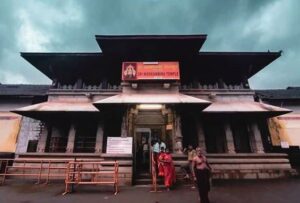 Adi Para Shakthi, the Goddess Kollur Mookambika Devi is our cosmic mother. She is regarded as the one who nourishes and nurtures of the world. So pilgrims, especially Hindus from all over the world visit Kollur Mookambika Temple. Devotees undertake Kollur pilgrimage to change their fortunes by worshipping the Goddess Kollur Mookambika. All kinds of people, whether they are rich or poor, young or old, sick or healthy visit the holy temple of Kollur Mookambika. She is an embodiment of all divine powers. Kollur Mookambika graces in a sitting form with discus and conch in hands representing Kali, Mahalakshmi and Sarasvathi.
Adi Para Shakthi, the Goddess Kollur Mookambika Devi is our cosmic mother. She is regarded as the one who nourishes and nurtures of the world. So pilgrims, especially Hindus from all over the world visit Kollur Mookambika Temple. Devotees undertake Kollur pilgrimage to change their fortunes by worshipping the Goddess Kollur Mookambika. All kinds of people, whether they are rich or poor, young or old, sick or healthy visit the holy temple of Kollur Mookambika. She is an embodiment of all divine powers. Kollur Mookambika graces in a sitting form with discus and conch in hands representing Kali, Mahalakshmi and Sarasvathi.
The holy idol in Mookambika temple is made up of Panchaloha i.e. a combination of five metals namely Gold, Silver, Copper, Iron and Lead and is believed to be placed by Shri Adi Shankaracharya during his visit to the holy state.
Devi Mookambika is believed to have appeared before Adi Shankaracharya and agreed to travel with him towards his state, present Kerala. On the way, however, they came across the sacred Jyotirlinga, once worshipped by Kolha Maharishi. Being aware about the future, Devi told Adi Shankaracharya that it is required that she should merge into this Jyotirlinga. The Jyotirlinga from now would be having a golden line dividing it into two. The right side will be the abode of the Trimurthis and the larger left side will be the abode of Parvathi, Lakshmi and Saraswathi. With this, she disappeared into the Linga and a glowing golden line spread across it. Since then Goddess Mookambika is worshipped in the form of Jyothirlinga that incorporates both Shiva (Trimurthi) on the left side and Shakti (Tridevi) on right side demarcated by a golden rekha (line).
Shri Adi Shankaracharya then installed an idol of Mookambika above the Linga and worshipped them both. Eventually, this idol and the Jyotirlinga are the ones around which the present-day temple is built. The idol is one of the holiest and most pious among Hindus and hence is held in high sanctity.
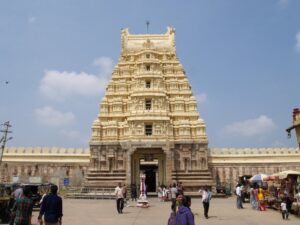 Ranganathaswamy Temple, a beautifully carved temple complex, is located in Srirangapatna in the south-western state of Karnataka, India. The temple is dedicated to Lord Ranganatha who is an avatar of Lord Vishnu in Hindu religion. Do take a minute to notice the beautiful carvings at the entrance Gopuram of the temple. The complex is surrounded by the River Kaveri which adds to the beauty of the temple. The ghats of the river are frequented for taking a dip before entering the holy temple complex.
Ranganathaswamy Temple, a beautifully carved temple complex, is located in Srirangapatna in the south-western state of Karnataka, India. The temple is dedicated to Lord Ranganatha who is an avatar of Lord Vishnu in Hindu religion. Do take a minute to notice the beautiful carvings at the entrance Gopuram of the temple. The complex is surrounded by the River Kaveri which adds to the beauty of the temple. The ghats of the river are frequented for taking a dip before entering the holy temple complex.
In Hinduism, the Sri Ranganathaswamy Temple in Srirangapatna is considered as one of the five most important and sacred shrines devoted to Lord Vishnu. These sites are called Pancharanga Kshetram and are of very high religious importance. The presiding deity of this temple is the Adi Ranga, or the 'first Ranga'. The temple has a rich history associated with it and is visited by devotees from all over the world. It comes under the Archaeological Survey of India.
The idol of Lord Ranganatha is seen in a reclining posture over the Sheshanaga. An inscription in the temple premises indicates that the shrine was first sanctified around 984 AD. Innumerable architectural intricacies make the Sri Ranganathaswamy Temple an enthralling architectural marvel and must be included on your list of places to visit.
The best time to visit the Sri Ranganathaswamy Temple is between July and September, during the monsoons. This is the best time as River Kaveri gushes with all its might and the sight is breathtaking. Some may also choose to visit the temple between October and December as the weather is quite pleasant for exploring the site during the winters.
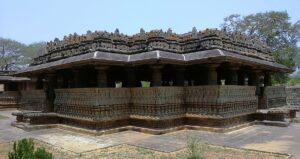 Nagareshvara temple is one of the age-old temples, located in Bankapura, of Haveri district. This temple dates back to the 12th century and is structured in the style of Western Chalukya or Kalyani Chalukya architecture. Nagareshvara temple is renowned for its beautifully engraved 60 pillars and is called “Aravattu Kambada Gudi.” or the temple with 60 pillars. Except for the four pillars in Blackstone, all the others have been carved out of dark grey stone. The plain surfaces are well polished to reflect light.
Nagareshvara temple is one of the age-old temples, located in Bankapura, of Haveri district. This temple dates back to the 12th century and is structured in the style of Western Chalukya or Kalyani Chalukya architecture. Nagareshvara temple is renowned for its beautifully engraved 60 pillars and is called “Aravattu Kambada Gudi.” or the temple with 60 pillars. Except for the four pillars in Blackstone, all the others have been carved out of dark grey stone. The plain surfaces are well polished to reflect light.
Dedicated to Lord Shiva, this temple is famed for its architectural marvel. Though the temple was a center for study and research on Jainism, for some time, it was dedicated to Lord Shiva as, per one of the 16 inscriptions which, also bear references to the history of the place. The ceiling in the center, of this temple, has huge dome-shaped, concentric rings, opulent edges, and engraved flower motifs.
There is also a 52-acre Peacock Sanctuary, inside this temple premises, and measures have been taken, to protect the national bird, and its breed in this area. An extraordinary archaic temple, the relics of a significant fort, and a haven for alluring peacocks make Bankapur, ideal travel spots to explore.
The temple is assignable to the 12th century and belongs to the Western Chalukya art. It is constructed with soap stone material and comprises a small shrine and a closed hall that connects to a large open hall or Mahamantapa. The sanctum is connected to the large hall via vestibule and at the end of the large hall, facing the sanctum is an open Nandimantapa. The highlight of the large hall are the bell shaped lathe turned pillars of soap stone. The pillars are so well polished that they sparkle with reflected light. The main decoration on these pillars are the horizontal rings of moldings.
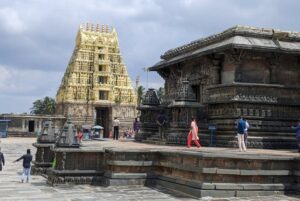 Chennakeshava Temple, also referred to as Keshava, Kesava or Vijayanarayana Temple of Belur, is a 12th-century Hindu temple in, Hassan district of Karnataka state, India. It was commissioned by King Vishnuvardhana in 1117 CE, on the banks of the Yagachi River in Belur, an early Hoysala Empire capital. The temple was built over three generations and took 103 years to finish. It was repeatedly damaged and plundered during wars, repeatedly rebuilt and repaired over its history. It is 35 km from Hassan city and about 220 km from Bengaluru.
Chennakeshava Temple, also referred to as Keshava, Kesava or Vijayanarayana Temple of Belur, is a 12th-century Hindu temple in, Hassan district of Karnataka state, India. It was commissioned by King Vishnuvardhana in 1117 CE, on the banks of the Yagachi River in Belur, an early Hoysala Empire capital. The temple was built over three generations and took 103 years to finish. It was repeatedly damaged and plundered during wars, repeatedly rebuilt and repaired over its history. It is 35 km from Hassan city and about 220 km from Bengaluru.
Chennakesava (lit, "handsome Kesava") is a form of the Hindu god Vishnu. The temple is dedicated to Vishnu and has been an active Hindu temple since its founding. It is reverentially described in medieval Hindu texts and remains an important pilgrimage site in Vaishnavism.The temple is remarkable for its architecture, sculptures, reliefs, friezes as well its iconography, inscriptions and history. The temple artwork depicts scenes of secular life in the 12th century, dancers and musicians, as well as a pictorial narration of Hindu texts such as the Ramayana, the Mahabharata and the Puranas through numerous friezes.It is a Vaishnava temple that reverentially includes many themes from Shaivism and Shaktism, as well as images of a Jina from Jainism and the Buddha from Buddhism. The Chennakeshava temple is a testimony to the artistic, cultural and theological perspectives in 12th-century South India and the Hoysala Empire rule.
The four central pillars are notable for having been The navaranga hall has forty eight pillars. All except the central four are carved in a unique way. The central four are later additions, added in 1381 CE during the Vijayanagara Empire era, to support the internal structure of a damaged temple.The pillars are of three sizes. Two pillars are particularly notable. One is the so-called Narasimha pillar which is carved with miniature figures from top to bottom, such as a tiny bull (kadale basava). The local legend states that this pillar once could rotate because of how it was supported, but it no longer can be rotated.The other pillar is the Mohini pillar. Other than the female avatar of Vishnu, the pillar has eight bands of carvings, including those of Brahma, Vishnu, Shiva, then ten avatars of Vishnu, the eight direction deities, mythical animals with the body of a lion but the face of other hand carved while the others were lathe turned.
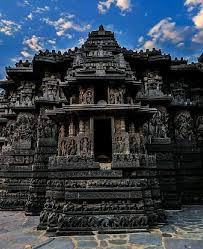 Hoysaleswara temple, also referred simply as the Halebidu temple, is a 12th-century Hindu temple dedicated to Lord Shiva. It is the largest monument in Halebidu, a town in the state of Karnataka, India and the former capital of the Hoysala Empire. The temple was built on the banks of a large man-made lake, and sponsored by King Vishnuvardhana of the Hoysala Empire.Its construction started around 1121 CE and was complete in 1160 CE. During the early 14th century, Halebidu was twice sacked and plundered by the Muslim armies of the Delhi Sultanate from northern India, and the temple and the capital fell into a state of ruin and neglect. It is 30 kilometres (19 mi) from Hassan city and about 210 kilometres (130 mi) from Bengaluru.
Hoysaleswara temple, also referred simply as the Halebidu temple, is a 12th-century Hindu temple dedicated to Lord Shiva. It is the largest monument in Halebidu, a town in the state of Karnataka, India and the former capital of the Hoysala Empire. The temple was built on the banks of a large man-made lake, and sponsored by King Vishnuvardhana of the Hoysala Empire.Its construction started around 1121 CE and was complete in 1160 CE. During the early 14th century, Halebidu was twice sacked and plundered by the Muslim armies of the Delhi Sultanate from northern India, and the temple and the capital fell into a state of ruin and neglect. It is 30 kilometres (19 mi) from Hassan city and about 210 kilometres (130 mi) from Bengaluru.
The Hoysaleswara temple is a Shaivism tradition monument, yet reverentially includes many themes from Vaishnavism and Shaktism tradition of Hinduism, as well as images from Jainism. The Hoysaleswara temple is a twin-temple dedicated to Hoysaleswara and Santaleswara Shiva lingas, named after the masculine and feminine aspects, both equal and joined at their transept. It has two Nandi shrines outside, where each seated Nandi face the respective Shiva linga inside.
The temple includes a smaller sanctum for the Hindu Sun god Surya. It once had superstructure towers, but no longer and the temple looks flat. The temple faces east, though the monument is presently visited from the north side. Both the main temples and the Nandi shrines are based on a square plan.The temple was carved from soapstone. It is notable for its sculptures, intricate reliefs, detailed friezes as well its history, iconography, inscriptions in North Indian and South Indian scripts. The temple artwork provides a pictorial window into the life and culture in the 12th century South India. About 340 large reliefs depict the Hindu theology and associated legends. Numerous smaller friezes narrate Hindu texts such as the Ramayana, the Mahabharata and the Bhagavata Purana. Some friezes below large reliefs portray its narrative episodes.
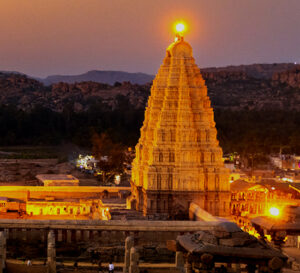 Virupaksha Temple (ʋɪruːpaː'kʂɐ) is located in Hampi in the Vijayanagara district of Karnataka, India. It is part of the Group of Monuments at Hampi, designated as a UNESCO World Heritage Site. The temple is dedicated to Sri Virupaksha, a form of Shiva. The temple was built by Lakkan Dandesha, a nayaka (chieftain) under the ruler Deva Raya also known as Prauda Deva Raya of the Vijayanagara Empire.
Virupaksha Temple (ʋɪruːpaː'kʂɐ) is located in Hampi in the Vijayanagara district of Karnataka, India. It is part of the Group of Monuments at Hampi, designated as a UNESCO World Heritage Site. The temple is dedicated to Sri Virupaksha, a form of Shiva. The temple was built by Lakkan Dandesha, a nayaka (chieftain) under the ruler Deva Raya also known as Prauda Deva Raya of the Vijayanagara Empire.
Hampi, capital of the Vijayanagara empire, sits on the banks of the Tungabhadra River (Pampa hole/Pampa river). Virupaksha Temple is the main center of pilgrimage at Hampi, and had been considered the most sacred sanctuary over the centuries. It is intact among the surrounding ruins and is still used in worship . The temple is dedicated to Lord Shiva, known here as Virupaksha/Pampa pathi, as the consort of the local goddess Pampadevi who is associated with the Tungabhadra River. There is also a Virupakshini Amma temple (mother goddess) in a village called Nalagamapalle, Chittoor district, Andhra Pradesh, approximately 100 km from Tirupati.
At present, the main temple consists of a sanctum, three ante chambers, a pillared hall and an open pillared hall. It is decorated with delicately carved pillars. A pillared cloister, entrance gateways, courtyards, smaller shrines and other structures surround the temple.The nine-tiered eastern gateway, which is the largest at 50 meters, is well-proportioned and incorporates some earlier structures. It has a brick superstructure and a stone base. It gives access to the outer court containing many sub-shrines.The smaller eastern gateway leads to the inner court with its numerous smaller shrines.
Another gopuram towards north known as the Kanakagiri gopura, leads to a small enclosure with subsidiary shrines and eventually to the river Tungabhadra.
A narrow channel of the Tungabhadra River flows along the temple's terrace and then descends to the temple-kitchen and out through the outer court.
